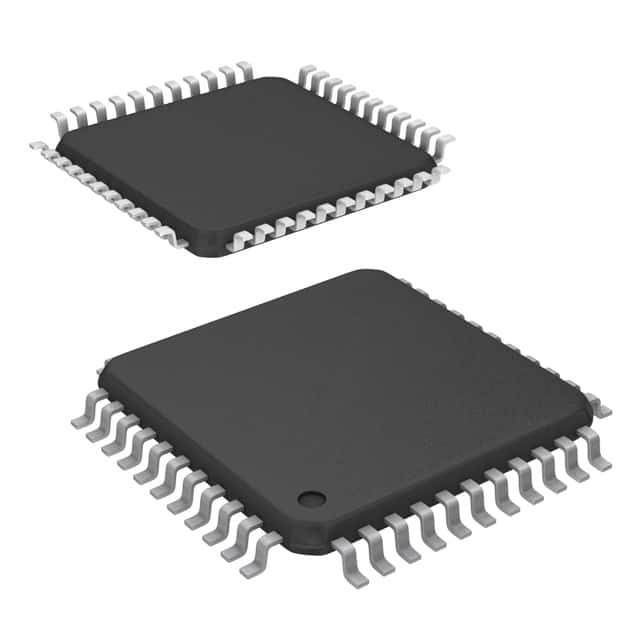P89V51RD2FBC,557
Basic Information Overview
- Category: Microcontroller
- Use: Embedded systems, industrial automation, consumer electronics
- Characteristics: 8-bit microcontroller, high-performance, low-power consumption
- Package: 40-pin Dual In-Line Package (DIP)
- Essence: Central processing unit for controlling electronic devices
- Packaging/Quantity: Individually packaged, quantity varies based on supplier
Specifications
- Architecture: 8051
- CPU Speed: Up to 33 MHz
- Program Memory: 64 KB Flash
- Data Memory: 1 KB RAM
- I/O Pins: 32
- Timers/Counters: 3
- Serial Communication: UART, SPI, I2C
- ADC Channels: 8-bit, 8 channels
- Operating Voltage: 2.7V to 5.5V
- Operating Temperature: -40°C to +85°C
Detailed Pin Configuration
- P0.0 - Port 0, Pin 0
- P0.1 - Port 0, Pin 1
- P0.2 - Port 0, Pin 2
- P0.3 - Port 0, Pin 3
- P0.4 - Port 0, Pin 4
- P0.5 - Port 0, Pin 5
- P0.6 - Port 0, Pin 6
- P0.7 - Port 0, Pin 7
- RST - Reset Pin
- P1.0 - Port 1, Pin 0
- P1.1 - Port 1, Pin 1
- P1.2 - Port 1, Pin 2
- P1.3 - Port 1, Pin 3
- P1.4 - Port 1, Pin 4
- P1.5 - Port 1, Pin 5
- P1.6 - Port 1, Pin 6
- P1.7 - Port 1, Pin 7
- XTAL1 - Crystal Oscillator Input
- XTAL2 - Crystal Oscillator Output
- GND - Ground
- VCC - Power Supply
- P2.0 - Port 2, Pin 0
- P2.1 - Port 2, Pin 1
- P2.2 - Port 2, Pin 2
- P2.3 - Port 2, Pin 3
- P2.4 - Port 2, Pin 4
- P2.5 - Port 2, Pin 5
- P2.6 - Port 2, Pin 6
- P2.7 - Port 2, Pin 7
- ALE/PROG - Address Latch Enable/Program Pin
- PSEN - Program Store Enable
- EA/VPP - External Access Enable/Voltage Programming Pin
- P3.0 - Port 3, Pin 0
- P3.1 - Port 3, Pin 1
- P3.2 - Port 3, Pin 2
- P3.3 - Port 3, Pin 3
- P3.4 - Port 3, Pin 4
- P3.5 - Port 3, Pin 5
- P3.6 - Port 3, Pin 6
- P3.7 - Port 3, Pin 7
Functional Features
- 8-bit microcontroller with a wide range of peripherals
- High-performance CPU capable of executing complex instructions
- Low-power consumption for energy-efficient applications
- Flexible serial communication interfaces for data transfer
- On-chip Flash memory for program storage
- Built-in timers/counters for precise timing operations
- Analog-to-Digital Converter (ADC) for sensor interfacing
- Wide operating voltage range for compatibility with various power sources
Advantages and Disadvantages
Advantages
- Versatile microcontroller suitable for a wide range of applications
- Efficient execution of complex instructions
- Low power consumption extends battery life in portable devices
- Ample program and data memory for most embedded systems
- Multiple communication interfaces simplify integration with other devices
Disadvantages
- Limited processing power compared to 16 or 32-bit microcontrollers
- Relatively small RAM size may restrict certain applications
- Lack of advanced features found in more modern microcontrollers
- Limited availability of alternative models with similar specifications
Working Principles
The P89V51RD2FBC,557 microcontroller is based on the
Lista 10 Vanliga frågor och svar relaterade till tillämpningen av P89V51RD2FBC,557 i tekniska lösningar
Sure! Here are 10 common questions and answers related to the application of P89V51RD2FBC,557 in technical solutions:
Q: What is the P89V51RD2FBC,557 microcontroller? A: The P89V51RD2FBC,557 is a popular 8-bit microcontroller from NXP Semiconductors, based on the 8051 architecture.
Q: What are the key features of the P89V51RD2FBC,557 microcontroller? A: Some key features include 64KB Flash memory, 1024 bytes of RAM, 32 I/O pins, UART, SPI, and I2C interfaces, and an on-chip ISP programming capability.
Q: How can I program the P89V51RD2FBC,557 microcontroller? A: The microcontroller can be programmed using In-System Programming (ISP) via UART or SPI interface, or by using a conventional programmer like Flash Magic.
Q: Can I use C/C++ programming language to develop applications for the P89V51RD2FBC,557? A: Yes, you can use C/C++ programming languages along with the Keil C51 compiler or SDCC (Small Device C Compiler) to develop applications for this microcontroller.
Q: What are some typical applications of the P89V51RD2FBC,557 microcontroller? A: It is commonly used in various embedded systems applications such as industrial automation, home automation, robotics, motor control, and consumer electronics.
Q: Does the P89V51RD2FBC,557 support interrupts? A: Yes, the microcontroller supports both external and internal interrupts, allowing efficient handling of time-critical events.
Q: What is the maximum clock frequency of the P89V51RD2FBC,557? A: The microcontroller can operate at a maximum clock frequency of 40 MHz, allowing for high-speed processing in demanding applications.
Q: Can I interface external memory with the P89V51RD2FBC,557? A: Yes, the microcontroller supports external memory interfacing through its address and data bus, allowing for expanded storage capacity if needed.
Q: Does the P89V51RD2FBC,557 have built-in analog-to-digital converters (ADC)? A: No, the microcontroller does not have built-in ADCs. However, you can use external ADC modules to convert analog signals into digital values.
Q: Is there any development board available for the P89V51RD2FBC,557? A: Yes, there are several development boards available that feature the P89V51RD2FBC,557 microcontroller, making it easier to prototype and test your applications.
Please note that these answers are general and may vary depending on specific requirements and implementations.


